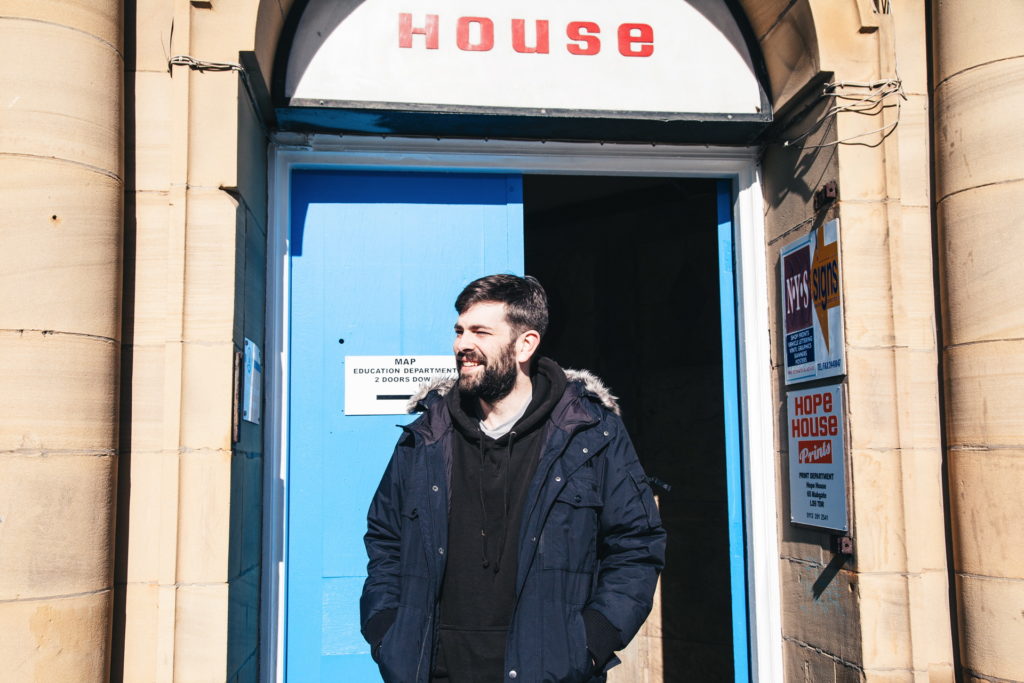Learning to the beat
What have a bunch of people dancing in a club got to do with helping kids excluded from mainstream education? At MAP in Leeds, the talent of Britain’s creative industries is being nurtured
Stop us if you’ve heard this track before. Cherished club night becomes surrounded by local property boom. Rents skyrocket, major development threatens independence. It’s a familiar tune, and one on repeat at Cosmic Slop club night in Leeds. But in every other sense, this isn’t like most parties.
“Your heart would break if you knew these kids. They’re not naughty, just vulnerable.”
Foresaking the city centre for Mabgate to the north, every month or so dedicated regulars descend on the Grade II listed Hope House to hear residents and high profile international DJs spin records. Guests have included Four Tet, Floating Points and Hunee, with the likes of Detroit house legend Theo Parrish and UK rave hero Paul Woolford considering the sound system among the world’s greatest. It was hand built by Tom Smith, who set the event up with cohorts Mike Greenwell and Nick Vale.
The renowned party, now in its seventh year, makes no money and instead raises funds for the charity Music and Arts Production (MAP), housed in another part of the building. Established in 2008 by Smith and friend Charlie Stobbart, the project works with 11-16 year olds at risk of exclusion from mainstream education, providing professionally delivered training in music production, art, design and mixed media, and also teaching core subjects like English and maths within a creative context – a direct response to requests from those enrolled. The goal is for attendees to ultimately return to school, but of those who finished year 11 here in 2015-16, 81 per cent achieved formal qualifications.
“One criticism we get is ‘taking the naughty kids and giving them all these advantages’. But your heart would break if you knew the stories of these kids. They’re not naughty, just vulnerable. Or some might be naughty, but maybe that’s for reasons as well – it’s not their fault but the environment they grew up in,” explains Smith when we meet in Hope House, a labyrinthine Victorian address as faded as it is grand.
If the way the organisation part-finances running costs is irregular – with schools paying subsidised rates to refer pupils – the professional community that has blossomed around it is truly unique. Large parts of the building remain unused but elsewhere you’ll find the likes of a graphic design agency, woodworker, screen and garment printing specialist, music and electrical technician.
These enterprises are not just neighbours but integral to the DIY economy. MAP attendees see how creative skills can lead to successful careers, learning from the practitioners and gaining inspiration as to where their own talents could take them.
“We are trialling apprenticeships at the moment and have a vision to expand the education project for 11-16 year olds. We want to offer something substantial beyond that, which we currently don’t. We can help with CVs, college guidance, taking people to interviews, but the resources are limited for much more,” Smith continues.
Getting to this point hasn’t been smooth. Although Smith and Stobbart were both youth workers before striking out alone, inexperience in the formalities involved in registering as an alternative off-site education provider almost had them closed down the moment they started. They were forced to change the type of qualifications they offered, from Arts Awards and NOCNs (previously National Open College Network) to more widely recognised Edexcel BTECs. And because of the expansion of Leeds city centre the future for Hope House, and all that resides there, also looks rocky – but far from bleak.

“The building we are in has planning permission to turn it into flats. Same across the road, here, there, everywhere. There are a lot of independent businesses in this area that are under threat, not just from redevelopment but also increasing rents,” says Smith.
“The owners of Hope House have been really good with us. We handled our contracts very professionally, with long terms, checking for rent increases, avoiding rolling 12-month tenancies. As soon as we saw what we were doing was working we went for a 10-year lease. We’ve been talking with the owner about the future and he has told us he’d rather see our work here continue as a charity and see our vision realised than knock it into 20 flats. But business is business.”
The landlord is even offering advice to MAP on its bid to buy Hope House. MAP’s long-term goals are to take ownership of the address, expand on training provision and introduce a café and outdoor area – with a greenhouse already under construction and seed bank growing in preparation down in the basement. There are also plans for a more comprehensive approach to education.
Using the model already in place, Smith wants to “provide a mechanism for the goodwill of creative professionals to be responsible for the community that surrounds them”. To put that another way, continue filling the building with like-minded businesses that want to encourage the next generation to think big, in spite of any difficult backgrounds they may have come from. He estimates that would need £2.4 million investment.
Sixteen-year-old Taylor Jay Hogan attended the programme from school years nine to 11, progressing from one day a week to three before graduating in May. In September she begins an A2 level in creative digital media, a direct result of her time at Hope House, with her application for further education accepted on the back of the portfolio she developed at MAP.
“I would say that the biggest benefit is that MAP has sculpted my future, as I was able to develop a passion for filmmaking and tie it in to my qualification. MAP has boosted my confidence so much since I started, as I was very quiet, but because everyone was so welcoming it made me progress in my social skills and self-esteem,” she explains.
“I think the main reason for MAP’s success is that it is such a calm and welcoming environment, so when you are getting on with your work you are really enjoying it.”
At 18, MAP’s first apprentice, Yefe Fiyah, is close in age to those on the programme and can seen the value it has.
“I don’t know anyone else who gets the opportunities I do. There are so many skilled people here to learn from, and it’s all in one place,” says Fiyah. He has begun producing music and is considering whether to enroll in college once his apprenticeship has finished or to set up in Hope House for himself. “I think MAP is very important. It cools kids down, treats it less as a teacher-student relationship.”
On Mondays to Thursdays he assists in every aspect of the organisation. That includes educational support across the 11-16 year old programme and also working with professionals in disciplines such as wood, graphics and printing, alongside time assisting in the administrative office. That offers the kind of business understanding needed to pursue his own independent goals, which are being shaped by experiences here.
“I’d like to be on the education programme. The kids take to me, because I’m not old but not their age. So I bridge the gap. Seeing how they go out in year 11 just shows that there is a big turning point here, a massive transition, like a click. Some go to other off-site programmes and you hear they’re kicking off, but you couldn’t imagine that because of how they are when they’re here.”
The story is all the more powerful given artistic aspiration among young people is increasingly devalued in the UK, and approaches to nightlife often border on hostile. Not just another bunch of people dancing to tunes ranging from disco and funk to house and techno after midnight, Cosmic Slop is proof that parties can have a meaningful impact on society.
MAP has taken those nightlife values of freedom, the breaking down of social and class barriers, and openness to fresh ideas and distilled them into a daytime education programme that nurtures tomorrow’s talent, without which the future of Britain’s world famous creative industries looks far more vulnerable.

Leave a reply
Your email address will not be published.